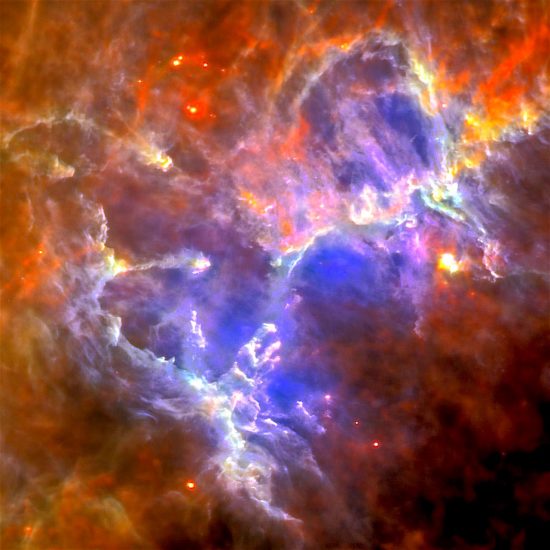
Jan 31. 2019
Cold gas does not give birth to stars.
“A very great vision is needed, and the man who has it must follow it as the eagle seeks the deepest blue of the sky.”
— Crazy Horse
The Eagle nebula is located in the constellation Serpens, approximately 7000 light-years away, as astronomers measure distance. It is supposedly a “star nursery”, since images reveal it to be a multi-spectral cloud of gas mixed with microscopic particles of cold dust.
Astrophysicists believe that cold dust is necessary when stars form in nebulae. Gas and dust start to heat up as they collapse, because greater density causes higher temperatures. In that case, the common idea that stars form out of dusty clouds becomes problematic. In essence, the laws of thermodynamics insist that matter expands as it heats up—outward pressure opposes the force of gravity. In that case, atoms in the gas can never undergo nuclear fusion. That requires conventional astronomers to come-up with something that contradicts essential facts. They believe that if dust in the nebula is cold enough, heat created in gravitational collapse will radiate away, so that new stars can ignite.
Nebulae are evidence for Electric Universe theory. Most of them emit light because they are electrically active in some regions. The middle of the Eagle Nebula is cold, so its dust clouds are only one degree above absolute zero. The glowing threads and bubbles indicate a powerful force overcoming temperature and pressure considerations.
Filamentary structures in the form of helical filaments extending from the central stars indicate Birkeland currents, named after Kristian Birkeland, who first proposed their existence in the late 1800s. They form scalable plasma structures that can transmit electric power all around the Galaxy. Electromagnetic forces will often cause them to “pinch” down to smaller scales.
Plasmas confined within the pinch increase in current density until the “z-pinch” produces a star. Plasmas surrounding the star will often glow, but in some conditions of opacity and density, the surrounding plasmas can be cold, revealing their presence only in infrared light.
As mentioned, stars are the foci of Birkeland currents that make up circuits flowing around the Galaxy. The electromagnetic pinches that squeeze plasmas into stars also form toroidal currents around their equators. Current density increases until plasmas in the ring start to glow. The Electric Universe explanation is that nebulae are plasma structures, and they behave according to the laws of electrical discharges and circuits.
Instead of mechanical action and cold gas, the Eagle Nebula’s radiant new stars were created in a boost of electric charge. It is not necessary to prevent young stars from heating up by shielding them in cold dust. The electrical sheaths around new stars receive input from galactic Birkeland currents in which they are immersed, and are pushed into a glow-mode discharge state. As charge flow increases, the glow-mode discharges change into arc-mode and become stars. Gravity has little to do with the processes of star formation.
Stephen Smith












